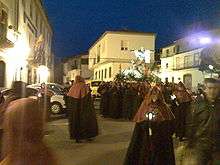Béjar
| Béjar | ||
|---|---|---|
| Municipality | ||
 | ||
| ||
 Béjar Location in Spain | ||
| Coordinates: 40°23′N 5°46′W / 40.383°N 5.767°WCoordinates: 40°23′N 5°46′W / 40.383°N 5.767°W | ||
| Country |
| |
| Autonomous community | Castile and León | |
| Province | Salamanca | |
| Comarca | Sierra de Béjar | |
| Judicial district | Béjar | |
| Founded | 400 BC | |
| Government | ||
| • Alcalde | Alejo Riñones (2011) (PP) | |
| Area | ||
| • Total | 45.74 km2 (17.66 sq mi) | |
| Elevation | 959 m (3,146 ft) | |
| Population (2008) | ||
| • Total | 13,403 | |
| • Density | 290/km2 (760/sq mi) | |
| Demonym(s) | bejarano | |
| Time zone | CET (UTC+1) | |
| • Summer (DST) | CEST (UTC+2) | |
| Postal code | 37700 | |
| Dialing code | 923 | |
| Website | Official website | |
Béjar is a town and municipality in the province of Salamanca, western Spain, part of the autonomous community of Castile and León. It lies 72 km (45 mi) had a population of 15,016 as of 2007.
History



The first inhabitants of what is now Béjar were the Vettones who settled an area to the south of the city now known as La Antigua around 400 BC. The city formed part of Roman Hispania in the beginning of the 1st century BC. In AD 713, the city was taken by Muslim Berbers (Moors) from the Visigoths and in the 11th century it was conquered by King Alfonso VI of Castile. Following this, the walls, part of which still stands, are constructed to repel frequent Arab incursions that took place until the definitive conquest.
The city was later the center of the Duchy of Béjar ruled by the powerful House of Zúñiga.
Name
The name Béjar is of pre-Roman origin. The original form was Bigerra[1] and is said to mean "place of the beehives." "Béjar" could be an adaption from the Spanish word abeja, which means "bee." An older spelling of the city's name is Béxar. In medieval documents, Vexar is found also.
Bexar County in the U.S. state of Texas acquired its name indirectly from this city.
Related articles
References
- ↑ Edward Gibbon. History of the Decline and Fall of the Roman Empire. Volume 5. Claxton, Remsen & Haffelfinger, 1873. p. 258.
External links
- i-Béjar web portal (in Spanish)
